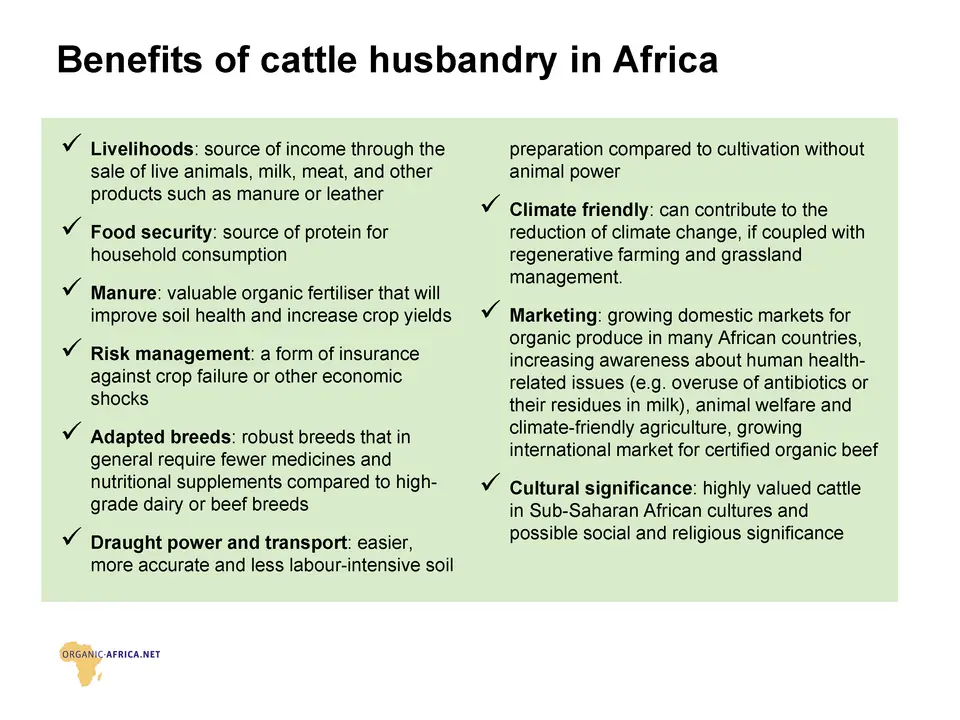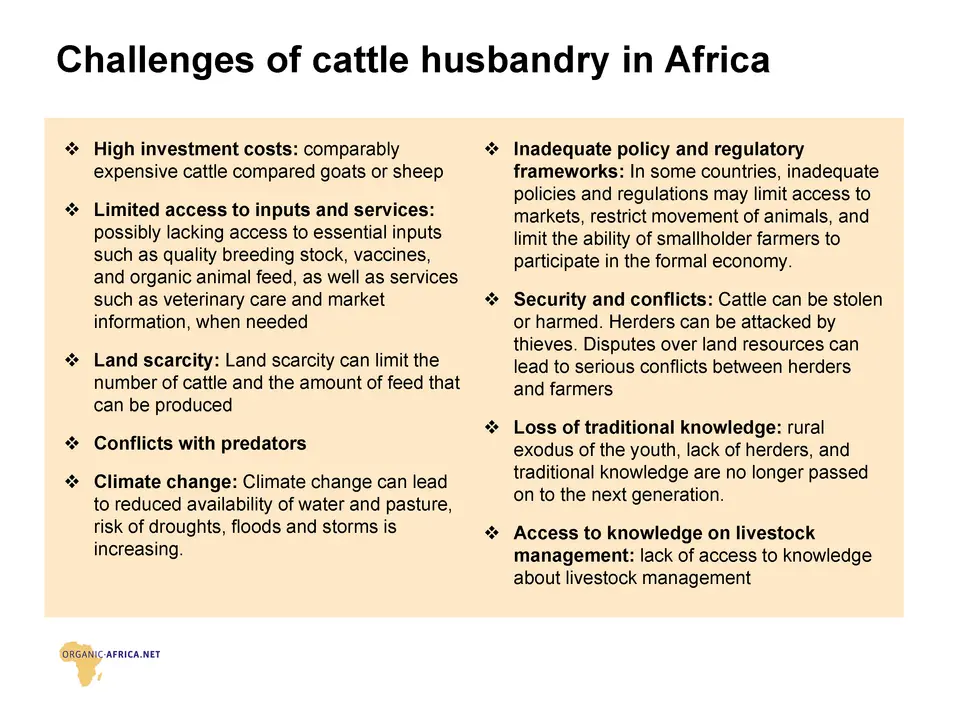Introduction
How to use this manual?
This manual is intended as a guide to basic information on organic and agroecological livestock farming for trainers of farmers, extensionists, and trainees. It is the trainer's task to select the relevant content to be taught in farmer trainings. These should then be adapted to the country and region-specific contexts and supplemented with practical examples.
Which production systems are the focus of this manual?
The manual deals, in particular, with the management of dairy cows in small-scale and medium-scale mixed crop-livestock farms, but other small-scale producers not focusing on milk production can also benefit from this manual. Although much of the content is useful for other production systems, the content is not explicitly tailored to (nomadic) pastoralist systems, agropastoral systems, and beef-producing ranching systems. Learn more about the different cattle production systems in Sub-Saharan Africa.
This manual focuses on agroecological and organic dairy cow, calf and (some) beef husbandry, whether it is certified organic or not. While demand for and production of organic crops are growing strongly in Africa, the market for certified organic beef and milk products (and other animal products) in Africa is still very small.
Nevertheless, in terms of overall farm management, it makes sense that livestock production is managed according to the requirements of organic farming on farms with organic crop production. Even if farms are not organically certified, they will benefit from agroecological livestock farming.
What are agroecological and organic farming?
Similarities: Agroecological and organic agriculture are both grounded in ecological thinking and have both the same goal: to work with nature to sustain and capitalise on the living systems and cycles, including soil, plants, animals, households, society and the environment.
Differences: Agroecology and organic farming both have principles, which are similar but not exactly the same:
- 13 principles of agroecology: Recycling, Input Reduction, Soil Health, Animal Health, Biodiversity, Synergy, Economic Diversification, Co-Creation of Knowledge, Social Values and Diets, Fairness, Connectivity, Land and Natural Resource Governance, Participation, Knowledge, Social Values and Diets, Fairness, Connectivity, Land and Natural Resource Governance, Participation
- 4 principles of organic agriculture: Health, Ecology, Care, Fairness
Another difference between agroecology and organic farming is that agroecology doesn’t have standards or regulations but for organic, there are pre-defined standards. A farm, that operates in compliance to organic standards can be certified. (Read more about “When do I need certification?”).
This manual talks about "organic dairy and cattle farming". This means that the practices and recommendations described here are in line with the principles of organic farming. However, it does not reflect any specific organic standards. Depending on the organic label, the relevant regulations must be consulted.
Why organic livestock farming?
Cattle provide numerous benefits for farmers in Sub-Saharan Africa:
- Livelihoods: Cattle farming can provide smallholder farmers with a source of income (through the sale of live animals, milk, meat, and other products such as manure or leather) as well as social networks and cultural knowledge.
- Food security: Cattle farming can provide a source of protein for household consumption which can also be sold or traded for other food items.
- Manure: The manure of cattle is a valuable organic fertiliser and will improve soil health and increase crop yields.
- Risk management: Cattle provide a form of insurance against crop failure or other economic shocks, as they can be sold or traded for cash during difficult times. Cattle also serve as a form of asset protection.
- Adapted breeds: Compared to conventional livestock husbandry, organic cattle husbandry relies on robust breeds that in general require fewer medicines and nutritional supplements.
- Draught power and transport: With the use of draught power, the preparation of soils is easier, more accurate and less labour-intensive. Cattle can pull relatively heavy wagons and thus make an important contribution to the transport of goods and people.
- Climate-friendly: If sustainable livestock husbandry is coupled with regenerative farming and grassland management, it can contribute to the reduction of climate change.
- Market options: Domestic markets for organic produce are growing in many African countries. With increased awareness about human health-related issues related to livestock products (e.g. overuse of antibiotics or their residues in milk), animal welfare and climate-friendly agriculture, the demand for organic animal produce may further increase over the next years in some countries. The international market for certified organic beef is growing, especially with exports to the European Union and United States. Some African countries such as South Africa have a well-established organic farming sector and export organic beef internationally.
- Cultural significance: Cattle are often highly valued in Sub-Saharan African cultures and may also have social and religious significance. Farmers who raise cattle may benefit from the social status that comes with ownership of these animals.
Challenges of organic and agroecological cattle farming in Sub-Saharan Africa:
- High investment costs: Compared to other livestock such as goats or sheep, cattle are comparably expensive.
- Limited access to inputs and services (if necessary): Smallholder farmers may lack access to essential inputs such as quality breeding stock, vaccines, and organic animal feed, as well as services such as veterinary care and market information.
- Land scarcity: Land scarcity can limit the number of animals that can be raised and the amount of feed that can be produced, which can limit the profitability of cattle farming. Cattle require significant resources such as land, water and feed. Smallholder farmers who have limited access to these resources may struggle to raise cattle efficiently.
- Conflicts with predators: In some areas, cattle are attacked by predators. Wildlife such as elephants can also be dangerous to herders or other people and can raid crops.
- Climate change: Climate change can lead to reduced availability of water and pasture, which can have negative impacts on cattle productivity and health. The risk of droughts, floods and storms is increasing.
- Inadequate policy and regulatory frameworks: In some countries, inadequate policies and regulations may limit access to markets, restrict movement of animals, and limit the ability of smallholder farmers to participate in the formal economy.
- Security and conflicts: Cattle can be stolen or harmed. Herders can be attacked by thieves. Disputes over land resources can lead to serious conflicts between herders and farmers, such as in Nigeria.
- Loss of traditional knowledge and lack of labor: Changing living conditions mean that it is often no longer the children who herd the cattle. In general, there is often a lack of herders and traditional knowledge is no longer passed on to the next generation.
- Access to knowledge on livestock management: At the same time, there is often a lack of access to knowledge about livestock management, which makes it difficult to adapt to this change of lifestyle.
While cattle can contribute to improvements to the farm system and the livelihoods of smallholder farmers in Africa, farmers should carefully consider the resources available to them and local conditions before deciding to invest in cattle. Other livestock such as goats, sheep, camels, or chickens can also be good, and sometimes even better, choices.


 tap and then scroll down to the Add to Home Screen command.
tap and then scroll down to the Add to Home Screen command.